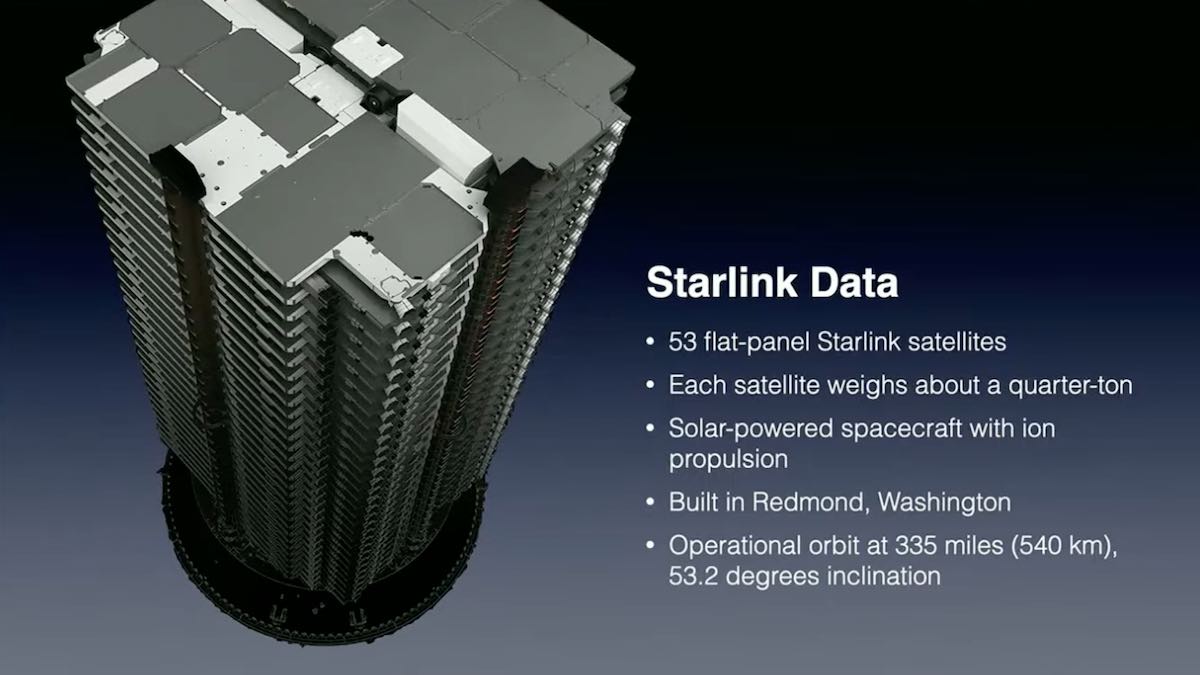
Continuing a record-breaking launch cadence, SpaceX sent a Falcon 9 rocket aloft Sunday from the Kennedy Space Center in Florida with 53 more satellites for the company’s Starlink internet network, the sixth Falcon 9 launch in 17 days and 33rd overall this year.
The launch Sunday was the 20th Falcon 9 mission of the year dedicated to deploying satellites for the Starlink network. SpaceX has now launched 1,013 Starlink satellites since the beginning of January.
A Falcon 9 rocket lifted off from pad 39A at the Kennedy Space Center at 9:38:20 a.m. EDT (1338:20 GMT) Sunday to begin SpaceX’s Starlink 4-25 mission. Fifty-three Starlink satellites rode into space atop the Falcon 9, flat-packed inside the rocket’s nose cone.
The satellites, each weighing more than a quarter-ton, will join SpaceX’s commercial network beaming low-latency, broadband internet signals to consumers around the world. SpaceX says Starlink connectivity is currently available in 36 countries, providing service to nearly a half-million subscribers.
Sunday’s launch followed a familiar profile for Starlink missions, with the Falcon 9 rocket heading northeast from Florida’s Space Coast. Nine kerosene-fueled Merlin 1D engines powered the Falcon 9 into the sky, burning for two-and-a-half minutes before switching off, allowing the first stage to separate from the Falcon 9’s upper stage.

A single Merlin engine on the upper stage fired for six minutes to inject the 53 Starlink satellites into orbit, targeting an altitude ranging between 144 miles and 210 miles (232-by-338 kilometers) at an inclination of 53.2 degrees to the equator.
The Falcon 9’s payload shroud jettisoned during the upper stage burn. A SpaceX recovery vessel downrange was in position to retrieve the two halves of the nose cone after parachuting into the sea.
The rocket’s reusable first stage — tail number B1062 in SpaceX’s fleet — also returned to Earth for landing on the drone ship “A Shortfall of Gravitas” parked in the Atlantic Ocean east of Charleston, South Carolina. The vertical, propulsive landing on the drone ship completed the booster’s eighth trip to space since entering service in November 2020.
The upper stage deployed the 53 Starlink satellites while flying over the North Atlantic Ocean about 15-and-a-half minutes into the mission. Four retention rods that kept the satellites firmly attached to the rocket released to allow the solar-powered Starlink spacecraft to fly free of the Falcon 9.
The satellites will naturally disperse from differential drag, extend their solar panels, and activate ion propulsion thrusters to begin climbing to their operational altitude of 335 miles (540 kilometers). The orbit-raising will take several weeks to several months, depending on the final operating plane for each satellite.

SpaceX has launched 2,957 Starlink satellites after Sunday’s mission, including prototypes and earlier spacecraft designs no longer in service. About 2,701 Starlink satellites are currently in orbit, with 2,665 spacecraft functional, and 2,155 Starlinks providing commercial internet service, according to a tabulation by Jonathan McDowell, an astrophysicist and expert tracker of spaceflight activity.
SpaceX’s Starlink network architecture includes orbital “shells” at different inclinations. SpaceX has filled the first orbital shell at 53.0 degrees inclination, and is currently launching satellites into the 53.2-degree layer and one of two polar-orbiting shells at an inclination of 97.6 degrees to the equator. SpaceX has also launched one Starlink mission into a 70-degree inclination shell. The company has not yet launched any dedicated missions into the other polar-orbiting shell.
The Starlink spacecraft are fitted with laser inter-satellite links to facilitate data transfers in orbit, without needing to relay signals through ground stations, which come with geographical, and sometimes political, constraints. Laser crosslinks can also reduce latency in the Starlink network because signals need to travel a shorter distance.
With 33 missions in the books for 2022, SpaceX is on pace for nearly 60 Falcon 9 launches this year, nearly double the 31 Falcon 9 flights accomplished in 2021. SpaceX has launched more successful missions into orbit so far this year than the combined efforts of any other nation, and the company is far outpacing its chief competitors in the commercial marketplace.

The launch Sunday was the final Falcon 9 flight scheduled for July
SpaceX’s next Falcon 9 launch is scheduled for Aug. 2 from Cape Canaveral with the Korea Pathfinder Lunar Orbiter, South Korea’s first space exploration mission. The Korean spacecraft will orbit the moon with a suite of cameras and science instrument from Korean research institutions and NASA.
Two more Starlink missions are also on tap in the first half of August, one from the Kennedy Space Center and one from Vandenberg Space Force in California.
Email the author.
Follow Stephen Clark on Twitter: @StephenClark1.
